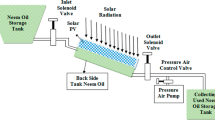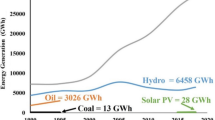Abstract
Purpose
High concentrated photovoltaic (HCPV) technology transforms solar radiation into electricity at efficiencies far higher than conventional PV cells. The aim of this paper is to evaluate the environmental impact of a commercial HCPV plant located in Morocco by determining the impact of this technology on a wide range of environmental categories. The results are expected to contribute to a better environmental design and performance of the power plant.
Methods
A complete life cycle inventory was gathered for a 1.008 MW HCPV power plant located in Casablanca (Morocco). The system was evaluated using a cradle to gate approach, considering 1 MWh as functional unit. ReCiPe Midpoint (World) evaluation method and Simapro Software were used for calculations. A sensitivity analysis on the life expectancy for 20, 25 and 30 years was also performed. Cumulative energy demand and energy payback time were determined for each scenario.
Results and discussion
The results showed an EPBT of 1.457 years and the following main environmental impacts: climate change 53.3 kg CO2 eq/MWh, freshwater eutrophication 28.3 g P eq/MWh, human toxicity 44.1 kg 1.4-DB eq/MWh, freshwater ecotoxicity 1.20 kg 1.4-DB eq/MWh and marine ecotoxicity 1.20 g 1.4-DB eq/kWh. Most of the impacts were associated with the extraction of raw materials and manufacturing of components, being aluminum and steel the materials with higher impacts. Normalization assigned the highest impacts to the toxicity categories, due mainly to the materials employed in the electronic devices and the aluminum used in the module manufacturing. The end-of-life stage had a significant positive effect on the performance of the plant, reducing the impact on each category by between 8 % (in ozone depletion) and 43 % (in particulate matter formation), due mainly to the recycling of steel and aluminum.
Conclusions
The power plant components manufacturing and the electricity consumption from the grid presented a high impact in the life cycle of the plant, implying a significant importance of the local electricity mix. An adequate recycling of the materials is recommendable, since it reduces considerably the impact of the system. The sensitivity analysis revealed a significant improvement in the environmental performance when increasing lifetime expectancy from 20 to 30 years.




Similar content being viewed by others
References
Aparicio D (2014) El mercado de las energías renovables en Marruecos. ICEX, Market Studies
Araújo GL, Martí A (1994) Absolute limiting efficiencies for photovoltaic energy conversion. Solar Energy Mater Sol Cells 33:213–240
Bravi M, Parisi ML, Tiezzi E, Basosi R (2011) Life cycle assessment of a micromorph photovoltaic system. Energy 36:4297–4306
Colthorpe A (2014) Soitec-Fraunhofer ISE multi-junction CPV cell hits world record 46% conversion efficiency. In: PV Tech. http://www.pv-tech.org/news/soitec_fraunhofer_ise_multi_junction_cpv_cell_hits_world_record_46_conversi
de Wild-Scholten M, Sturm M, Butturi MA, Noack M, Heasman K, Timò G (2010) Environmental sustainability of concentrator PV systems: Preliminary LCA results of the Apollon Project
EIA (2014) International energy outlook 2014. U.S. Energy information administration
Fthenakis VM, Kim HC (2011) Photovoltaics: life-cycle analyses. Sol Energy 85:1609–1628
Fthenakis VM, Kim HC (2013) Life cycle assessment of high‐concentration photovoltaic systems. Prog Photovolt Res Appl 21:379–388
Fthenakis V, Frischknecht R, Raugei M, Kim H, Alsema E, Held M, de Wild-Scholten M (2011) Methodology guidelines on life cycle assessment of photovoltaic electricity. IEA PVPS Task 12
Fthenakis V, Kim H, Frischknecht R, Raugei M, Sinha P, Stucki M (2011) Life cycle inventories and life cycle assessment of photovoltaic systems. International Energy Agency (IEA) PVPS Task 12
Hischier R, Weidema B, Althaus H, Bauer C, Doka G, Dones R, Frischknecht R, Hellweg S, Humbert S, Jungbluth N (2010) Implementation of life cycle impact assessment methods. Ecoinvent report
IEA, NEA (2010) Projected costs of generating electricity: edition 2010. International Energy Agency (IEA) and Nuclear Energy Agency (NEA)
International Energy Agency (IEA) (2015) World energy outlook 2015
Jungbluth N (2005) Life cycle assessment of crystalline photovoltaics in the Swiss ecoinvent database. Prog Photovolt Res Appl 13:429–446
Kammen D, Nelson J, Mileva A, Johnston J (2011) An assessment of the environmental impacts of concentrator photovoltaics and modeling of concentrator photovoltaic deployment using the SWITCH model. Renewable and Appropriate Energy Laboratory, Energy and Resources Group, University of California, Berkeley, Berkeley (CA)
Law DC, King RR, Yoon H, Archer MJ, Boca A, Fetzer CM, Mesropian S, Isshiki T, Haddad M, Edmondson KM, Bhusari D, Yen J, Sherif RA, Atwater HA, Karam NH (2010) Future technology pathways of terrestrial III–V multijunction solar cells for concentrator photovoltaic systems. Solar Energy Mater Sol Cells 94:1314–1318
Luque A, Hegedus S (2011) Handbook of photovoltaic science and engineering. John Wiley & Sons
Meijer A, Huijbregts M, Schermer J, Reijnders L (2003) Life‐cycle assessment of photovoltaic modules: comparison of mc‐Si, InGaP and InGaP/mc‐Si solar modules. Prog Photovolt Res Appl 11:275–287
Min C, Nuofu C, Xiaoli Y, Yu W, Yiming B, Xingwang Z (2009) Thermal analysis and test for single concentrator solar cells. J Semicond 30:044011
Nishimura A, Hayashi Y, Tanaka K, Hirota M, Kato S, Ito M, Araki K, Hu EJ (2010) Life cycle assessment and evaluation of energy payback time on high-concentration photovoltaic power generation system. Appl Energy 87:2797–2807
Padovani S, Del Negro A, Antonipieri M, Sinesi S, Campesato R, Casale M, Gabetta G, Gori G (2010) Triple junction InGaP/InGaAs/Ge solar cells for high concentration photovoltaics application: degradation tests of solar receivers. Microelectron Reliab 50:1894–1898
Peharz G, Dimroth F (2005) Energy payback time of the high‐concentration PV system FLATCON®. Prog Photovolt Res Appl 13:627–634
Peng J, Lu L, Yang H (2013) Review on life cycle assessment of energy payback and greenhouse gas emission of solar photovoltaic systems. Renew Sust Energ Rev 19:255–274
Polman A, Atwater HA (2012) Photonic design principles for ultrahigh-efficiency photovoltaics. Nat Mater 11:174–177
Raugei M, Bargigli S, Ulgiati S (2007) Life cycle assessment and energy pay-back time of advanced photovoltaic modules: CdTe and CIS compared to poly-Si. Energy 32:1310–1318
Turconi R, Boldrin A, Astrup T (2013) Life cycle assessment (LCA) of electricity generation technologies: overview, comparability and limitations. Renew Sust Energ Rev 28:555–565
Varun BIK, Prakash R (2009) LCA of renewable energy for electricity generation systems—a review. Renew Sust Energ Rev 13:1067–1073
Xie WT, Dai YJ, Wang RZ, Sumathy K (2011) Concentrated solar energy applications using Fresnel lenses: a review. Renew Sust Energ Rev 15:2588–2606
Acknowledgments
Thanks are due to BSQ Solar for providing the data. Thanks are also due to the European Commission for funding under HYSOL Project (Innovative Configuration for a Fully Renewable Hybrid CSP Plant, FP7-ENERGY-2012-1 CP 308912).
Author information
Authors and Affiliations
Corresponding author
Additional information
Responsible editor: Christian Bauer
Rights and permissions
About this article
Cite this article
Corona, B., Escudero, L., Quéméré, G. et al. Energy and environmental life cycle assessment of a high concentration photovoltaic power plant in Morocco. Int J Life Cycle Assess 22, 364–373 (2017). https://doi.org/10.1007/s11367-016-1157-y
Received:
Accepted:
Published:
Issue Date:
DOI: https://doi.org/10.1007/s11367-016-1157-y




